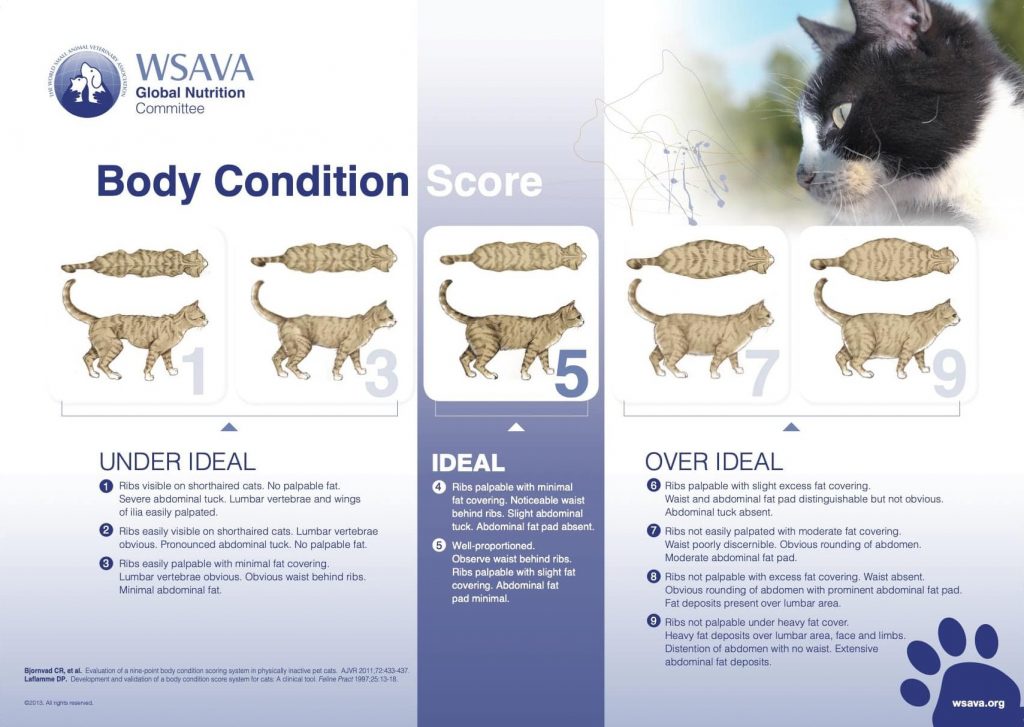The Importance of a Healthy Weight for Your Cat

The impact of body weight upon our health is well documented, and the same goes with our cats. Thankfully, we are the hand that feeds, so our cat’s weight is within our control. As with humans, an underweight or overweight cat is at greater risk of serious health problems, such as malnutrition, diabetes, chronic inflammation, heart disease, cancer and breathing difficulties. With continually improving science and research, we live in a time where we can give our cats the best in good nutrition for a long and healthy life.
Cats at Risk
According to the Animal Welfare League NSW, more than 30% of cats in Australia are overweight or obese. Middle aged cats of either sex are most at risk. Cats at greater risk of being underweight are either elderly or likely not microchipped nor desexed, according to this Australian study.
Ideal Weight
There is no one-size-fits-all weight range that all cats must fall into. Like us, cats’ bodies differ in frame size, muscle-to-fat composition and hydration levels. Your veterinarian likely uses the 9-point body condition score to assess their weight. They will advise you on any changes that need to occur for the benefit of your cat’s health. The chart below gives an idea of how to spot underweight or overweight cats.
The top view of a healthy weight cat may seem to some cat owners to be underweight. But what we should see is the ‘abdominal tuck’ – a noticeable indent between the hip and abdominal cavity. Think of it more as a waistline rather than a sign of low weight.
Another aspect of a cat’s build is the primordial pouch at the belly. Rather than signalling an overweight cat, it is a normal area of looser skin and added layer of fat designed to protect a cat’s organs in the instance of an attack. This paunch also allows for ease of flexibility in movement.

Transitioning to New Cat Food
A change to your cat’s meals will likely be necessary. But make this a careful, gentle transition. Some cats may have a robust digestive system with little to no reaction to a change in diet. However, most will likely react with an upset tummy.
The trick is to introduce new food slowly. Begin by replacing one quarter of their usual meal with their new cat food. Take note of changes in their litter box, and after two days of normal bowel movements, swap a further quarter of their old food with the new. Continue in this manner until all of their old food is replaced.
Cats are creatures of habit, and may display aversion to a new food. The above tactic should help. But remember that these stubborn creatures are sticklers for habit. They may resist the change and choose abstinence in protest. Be vigilant and patient with transitioning.
Your cat may also be looking for the enticement of palatants in their old cat food. Palatants are pet food additives that make it more appealing, and can lead to over-eating.
Mealtime and Portion Size
Free feeding is convenient, but it is a contributing factor to obesity in cats. It makes sense that veterinarians recommend controlled feeding times as well as adhering to portion sizes. Withdrawing from free feeding your cat is a necessary change. Removing the ever-present bowl of food will help you keep track of portion sizes, and it prevents a bored cat from over-snacking. However, clean drinking water must always be available, especially in the case of cats that eat dry cat food.
Treats are packed with calories and generally aren’t designed for nutrient value. Limit these, or better yet, cut them altogether. You can return to them sparingly once your cat has reached a healthy weight. Underweight cats do need an increase in calories, but treats should make up no more than 10% of their diet.
Choosing the Right Cat Food
Cats are obligate carnivores, meaning they need animal protein and fats to thrive. This may seem contrary to good health to some of us, but a cat’s digestive system is different and designed to digest animal meat. Cats lack the required enzymes to digest carbohydrates. They can munch on cat grass, which contains beneficial nutrients, and they tend to do so intuitively. Cat grass can help shift stubborn furballs, and the taste is appealing to cats. Rather than a grass species, cat grass is the collective term for grasses that are safe for cats to consume and include the grasses of barley, oat, rye and wheat.
The best cat food will contain the right balance of animal protein, fats and amino acids. Animal protein is necessary for a cat’s body to produce hormones, enzymes and muscle tissue. Animal protein contains essential amino acids that maintain brain and cardiovascular function.
Animal fats contain essential fatty acids including omega-3 and omega-6. These fatty acids maintain a cat’s immunity and assist with joint and eye health. Fatty acids help with inflammation and give cats a healthy coat.
Amino acids are the building blocks of proteins. Taurine, L-carnitine and arginine are essential amino acids. Taurine helps maintain good heart, eye and brain health, and assists digestion and immune system function.
L-carnitine can help with weight management and energy production as well as also assisting heart health and brain function.
Arginine is essential for healthy digestion and the elimination of toxins.
Check the cat food label carefully to ensure your cat’s food contains a good balance of these elements.
Playtime
According to a US study, most cats love to play. Researchers found 51% of cats prefer to play with other cats, 29% prefer playing with their owner and 18% enjoy both equally.
Most of us cat owners experience the early alarm clock in the form of a wakeful cat ready for the day. Cats are crepuscular, meaning they instinctively hunt in low light, such as at dawn and dusk. It makes sense that play, which is a domestic cat’s expression of hunting, can occur at these times of day.
What does this have to do with cat food? Engaging your cat in play is a useful tool in eliminating boredom and burning up energy resulting in lower restlessness. Lower levels of boredom and restlessness will reduce snacking in cats.
The practice of keeping exclusively indoor cats is undoubtedly increasing. Though our indoor cats live longer lives than their outdoor counterparts, they can lack the stimulation and activity of the outdoor lifestyle. Cat ownership must include playtime to compensate for inactivity. Cat toys can be as simple and budget friendly as a small ball or they can be elaborate and expensive. You can use a treat ball for them to bat around, or set up an rotating laser light toy. The important aspect is your time and consideration in helping them act out their true feline nature.
The Final Word
Cats that have a healthy weight will more likely live longer and higher quality lives with fewer health issues. Stubborn cats will resist change, but have courage. Your cat will adjust to new, healthier eating. And the rewards of better health and longer life for our cats are priceless.

